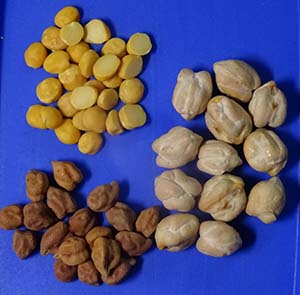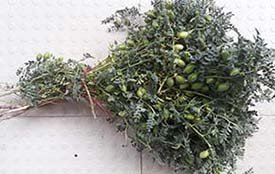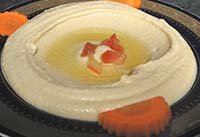Chickpea Nutrition facts
Chickpea or garbanzo bean is the fruit pod of a plant probably originally from the Middle East and Mediterranean. It is widely grown as an important leguminous field crop in India, Pakistan, Iran, and the USA.
Binomially, chickpeas belongs to the Fabaceae family, in the genus: Cicer. In India, the beans are called Bengal gram.
Scientific name: Cicer arietinum.
 |
| Desi, kabuli types and split Chickpea. |
Chickpea is a drought-tolerant, cool-season crop. It prefers well-draining, neutral-PH soil, supplemented by low day temperatures for optimum growth and seedpod development. The plant is a dicotyledonous, bushy shrub and bears small, pinnate-compound leaves.
 |
| Chickpea plant-Note for green seed pods. |
Unlike in other peas and beans, chickpea pods are short and swollen, containing 1-3 seeds. Depending on the variety, they can be pasty; some have a nutty flavor.
Desi type-chickpeas cultivated mainly in India and Pakistan. The duration of the crop is less than the Kabuli type. The seeds are smaller in size with a relatively thick seed coat coming in many different colors; reddish, green, brown, black, and cream-colored or almost black.
Kabuli type-The seeds are bigger with a smooth, waxy surface and thin cream-color seed coat. It is commonly grown in Persia, around the Mediterranean, and in the United States.
Health benefits of Chickpeas
Like other legumes, Garbanzo (chickpea) also contributes as a vital source of plant proteins, especially to the vegetarian population of Asia. They carry 378 calories and provide 19.47 g or 34% of the recommended daily values of protein.
They contain good levels of dietary fiber. Dietary fiber works as a bulk laxative that helps to protect the colon mucosa by decreasing its exposure time to toxic substances as well as by binding to cancer-causing chemicals in the colon. Dietary fiber has also been shown to reduce blood cholesterol levels by decreasing the reabsorption of cholesterol-binding bile acids in the colon.
Chickpeas, like soybeans, contain O-methylated isoflavone compound, Biochanin-A. Biochanin A is a plant estrogen. Studies suggest that it has a definitive role in anti-cancer diet programs.
Some of other isoflavones in them are glycitein, genistein, daidzein and formononetin. Isoflavones have been found to reduce post-menopausal cancers and osteoporosis.
Garbanzo beans are excellent sources of B-complex vitamins. 100 g dry, mature beans hold 557 µg or 134% of folates. Folate, along with vitamin B-12, is one of the essential co-factor for DNA synthesis and cell division. Adequate folate in the diet around conception and during pregnancy may help prevent neural tube defects in the newborn baby.
Futhermore, they compose very good levels of many B-complex vitamins, particularly vitamin-B6 (pyridoxine)-41% of DV, thiamin (vitamin B1)-40%, pantothenic acid-32%, riboflavin-16%, and niacin (10%). Most of these vitamins work as co-factors for the enzymes in carbohydrate, protein, and fat metabolism.
In addition, chickpea contains calcium-6%, iron-54%, copper-73%, zinc-25%, and phosphorus-36% of DV (daily values).
Potassium (15%) and sodium (1.6%) are the chief electrolytes found in them. Potassium is present in cells and body fluids, which helps counter the pressing effects of sodium on heart and blood pressure.
| Principle | Nutrient Value | Percent of RDA |
|---|---|---|
| Energy | 378 Kcal | 16% |
| Carbohydrates | 62.95 g | 48% |
| Protein | 20.47 g | 36% |
| Total Fat | 6.04 g | 30% |
| Cholesterol | 0 mg | 0% |
| Dietary Fiber | 12.2 g | 32% |
| Vitamins | ||
| Folates | 557 μg | 139% |
| Niacin | 1.541 mg | 10% |
| Pantothenic acid | 1.588 mg | 32% |
| Pyridoxine | 0.535 mg | 41% |
| Riboflavin | 0.212 mg | 16% |
| Thiamin | 0.477 mg | 40% |
| Vitamin-A | 67 IU | 2% |
| Vitamin-C | 4 mg | 6% |
| Electrolytes | ||
| Sodium | 24 mg | 1.6% |
| Potassium | 718 mg | 15% |
| Minerals | ||
| Calcium | 57 mg | 5.7% |
| Copper | 0.656 mg | 73% |
| Iron | 4.31 mg | 54% |
| Magnesium | 79 mg | 20% |
| Phosphorus | 252 mg | 36% |
| Zinc | 2.76 mg | 25% |
Selection and storage
Harvesting may be undertaken mechanically once the whole plant and seed pods turn yellow and dry under the sun. Threshing and winnowing methods are applied for seed separation. Unlike in other long bean varieties, seed dispersal is not common in chickpeas.
In the markets, choose dried garbanzo beans. The seed color would not come in the way of quality. In the US markets, dried chickpeas in bulk bins, and canned, sprouted, flour are available in supermarkets all year round.
At home, store dry garbanzo beans in an air-seal plastic/metallic bin in a cool, dry place away from high temperatures and humidity.
Young tender chickpea pods are also a delicacy and are treated much like vegetables in India (hara chana). Green chickpeas are stored for short periods. To enjoy, use them soon after the purchase.
Preparation and serving ideas
Soak chickpeas for 6-10 hours before cooking. They can be left to soak overnight and ready for cooking the next day. This reduces the cooking time by about 1 hour. In the pressure cooker, soaked peas were cooked for 20-25 minutes and without soaked, for 35-40 minutes.
Green chickpeas are picked when their pods are not yet dry, are shelled, and can be eaten raw or cooked as vegetable beans. The mature seeds, fresh, or dried are prepared in the same way as other legumes. Unlike most other beans, however, they do not disintegrate when cooked.
Here are some serving tips:
 |
| Hummus. Photo credit |
Boiled dry garbanzo beans are used in a variety of appetizers, soups, dips, and main dishes.
Boiled beans are delicious cold in mixed salads or pureed.
Whole and split chickpeas (chana dal) are popular ingredients in curry preparation which are served on rice. Choley or chana masala is one of the most popular dishes served with roti, or kulcha in India, Bangladesh, Nepal, and Pakistan.
Hummus is a Middle-eastern specialty dip prepared with boiled, mashed chickpeas, mixed with tahini and olive oil.
Falafel (special bean croquettes) is an Egyptian preparation based on chickpeas.
They are also items in several specialties from the south of France, in particular, its stews and hot pot dishes. Puchero is a Mexican hot pot dish and cocido madrilèno is a Spanish chickpea-based stew.
Chickpeas are one of the traditional ingredients in couscous dishes.
Chickpeas can be roasted or sprouted. Its flour (besan) is especially used for batters, unleavened breads and flatbreads.
Roasted chickpeas (bhuna chana), salted or unsalted, are often eaten as snacks in the same manner as peanuts in the Indian subcontinent.
Safety profile
Chickpea rarely causes food allergy. However, they often cause gaseous stomach distension and mild stomachache.
Methionine, the limiting amino acid, is deficient in them which could easily be compensated with the combination of rice/wheat in the food. (Medical disclaimer)
You may also like to read≻≻-
Adzuki beans nutrition facts and health benefits.
Lima beans nutrition facts and health benefits.
Fava beans nutrition facts and health benefits.
Soybeans nutrition facts and health benefits.
≻≻-Back to Legumes from Chickpea. Visit here for an impressive list of vegetables with complete illustrations of their nutrition facts and health benefits.
≻≻-Back to Home page.
Further Resources:
Stanford School of Medicine Cancer information Page- Nutrition to Reduce Cancer Risk.